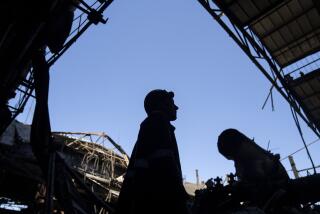Soviets Closing A-Plant Due to Fear of Quakes
- Share via
MOSCOW — Afraid that another massive earthquake in Armenia could cause an immense nuclear catastrophe, the Soviet Union on Saturday began shutting down a 12-year-old atomic power station outside the capital city of Yerevan.
The reactor in the station’s first, 407-megawatt unit was shut down early Saturday afternoon, the official Tass news agency reported from Yerevan; the second unit is scheduled to cease operating in three weeks, Tass said.
The station, 25 miles from Yerevan in the Ararat Valley, was scheduled to shut down in 1991 following years of strong public protests in Armenia over its location near a city of more than 1 million people. The deactivation then, halfway through its normal life, would have been the first of a nuclear plant here solely because of public pressure.
But the Moscow government decided to advance the closure on the advice of top Soviet scientists and foreign nuclear power specialists who inspected the station following the devastating Dec. 7 Armenian earthquake and urged that it be shut down as soon as possible.
Yevgeny P. Velikhov, a vice president of the Soviet Academy of Sciences and a top adviser to President Mikhail S. Gorbachev, said during a visit to Yerevan that the probability of major earth tremors in the area was so great that the plant had to be closed immediately even though it will deprive Armenia of a third of its electrical power.
The Nuclear Power Ministry meanwhile has canceled plans to build four new atomic power stations and expand two others, sharply curtailing the world’s largest nuclear power program after those of the United States and Japan. Work has been suspended as well on two reactors being added to another station.
Nikolai F. Lukonin, the minister, explained recently that several of the plants were located in seismic zones and that the others had to be redesigned to meet new safety standards following the 1986 explosion and fire at the Chernobyl nuclear power station that killed at least 31 people and injured more than 200.
Concern over the safety of the country’s 15 other nuclear power plants, which together have 43 reactors, has grown substantially as a result of the Chernobyl disaster and subsequent, smaller accidents at other plants. Strong anti-nuclear campaigns are under way in Lithuania, Byelorussia, the Ukraine, Georgia and parts of Russia as well as Armenia, and nuclear power has become an issue in the current parliamentary elections here.
Soviet authorities have replied with promises of improved safety standards, tighter management and more cautious consideration of the stations’ environmental impact.
Public’s Role Cited
“We have to work more closely with the public,” Lukonin said. “We have had some misunderstandings about the role of the public in the past.”
But Soviet officials also insist, as Gorbachev did last week while visiting Chernobyl, that the country’s economic growth requires greater use of nuclear power, which now accounts for about 13% of the nation’s electricity.
The nuclear power station outside Yerevan has two water-cooled, uranium-fueled reactors that can produce a total of 815 megawatts of electricity.
But the station, which is about 25 miles west of Yerevan, lies across a seismic fault, according to Soviet reports, and it was not built with the additional strength that leading Soviet scientists consider necessary to survive a major earthquake without serious damage.
A scientific task force had drawn up a seismic map of Armenia showing likely earthquake zones, according to Velikhov, and had correctly forecast the area around Spitak and Leninakan--the two cities hit hardest by the December earthquake--as “potentially a dangerous tremor zone.”
“The nuclear power station was included on a list of facilities (contained in the study) that needed to be given extra seismic stability as a matter of urgency,” Velikhov said. “Those measures had not been carried out in full.”
Velikhov, speaking on Soviet television and to Tass during his group’s trip to Yerevan, did not elaborate on what additional safety measures were required or why they had not been carried out, implying that political responsibility for the failure had yet to be assessed.
An Armenian scientist, Georgy I. Ter-Stepanyan, told the newspaper Komsomolskaya Pravda on Saturday that he and other scientists had objected to the plant when plans were first announced in the late 1960s, but their protests were rejected by both the national and local governments.
Not only was the plant built on the Ararat geological fault and thus vulnerable to earthquakes, Ter-Stepanyan said, but any radiation leak would contaminate Armenia’s main water source.
Although the plant was built to withstand earthquakes up to a magnitude of 8 and had suffered no damage from the December quake, which had a magnitude of 6.9, Velikhov’s delegation publicly expressed its serious concern about damage to the plant if a severe earthquake hit Yerevan directly rather than northern Armenia.
A Western earthquake specialist who participated in the study put the issue more bluntly: “An 8-point quake would probably bring down the station’s principal buildings, including those containing the control systems, and if the tremor were directly underneath, it could easily rupture the reactor chamber.”
Soviet authorities had earlier assured the public that automatic systems in the plant would shut it down immediately if there were an earthquake of 6 or more. The initial tremors in the Yerevan area on Dec. 7 reached 5.5 for more than three minutes, officials said, and were followed by a series of aftershocks. The plant continued to function through the earthquake, and no radioactive materials were released, they said.
Danger Acknowledged
Only after the Velikhov visit did the authorities reluctantly acknowledge the grave potential danger posed by a stronger earthquake or one whose epicenter was closer.
Armenian activists, concerned about the plant’s proximity to Yerevan, had long demanded its closure and won a commitment from the government last October to shut it down, by the end of 1991, although it would normally have a life of at least 30 years.
Tass said that the deactivation of the plant, including the removal and transfer of its fuel, will take several years.
More to Read
Sign up for Essential California
The most important California stories and recommendations in your inbox every morning.
You may occasionally receive promotional content from the Los Angeles Times.













